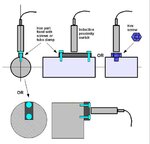nigelmercier
Member level 2
- Joined
- Nov 3, 2009
- Messages
- 47
- Helped
- 0
- Reputation
- 0
- Reaction score
- 0
- Trophy points
- 1,286
- Location
- United Kingdom
- Activity points
- 1,622
I've building a device that needs to sense when a shaft has turned 360°. My current prototype uses a Hall-Effect sensor, with a magnet on the shaft. However, it is quite critical as to the distance from the shaft, and I really don't want them to touch. I've also tried a light sensor, but this was worse.
I can't mount a sensor wheel on the end, or the perimeter of the shaft, it has to be something like a magnet or a dark stripe (the shaft is aluminum, 100mm diameter, about 250RPM). No need to detect direction or speed, just full rotations.
Any suggestions as to a sensor with more than a few mm of range?
I can't mount a sensor wheel on the end, or the perimeter of the shaft, it has to be something like a magnet or a dark stripe (the shaft is aluminum, 100mm diameter, about 250RPM). No need to detect direction or speed, just full rotations.
Any suggestions as to a sensor with more than a few mm of range?
